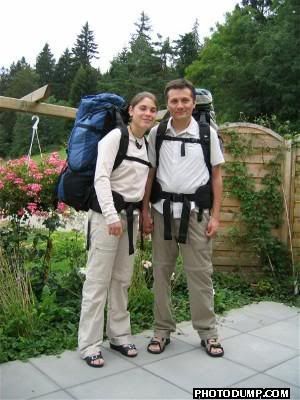Thursday, June 16, 2005
Malaysia: Sarawak, part 2
After having spent about 3 weeks around southern Sarawak, we finally caught a boat up north, to explore the legendary interior.
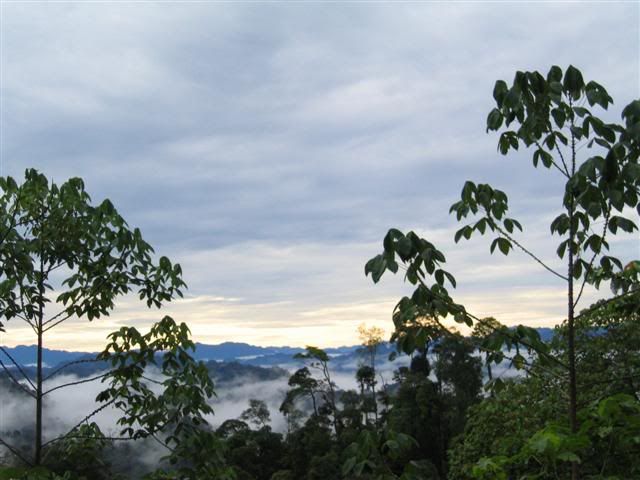
Up The Rajang River
The first leg of our journey took us to Sibu, somewhere at the wide mouth of the murky Rajang. There, we found a bustling chinese market town with a newly redesigned modern city centre and logs of tropical wood pilled on the docks.
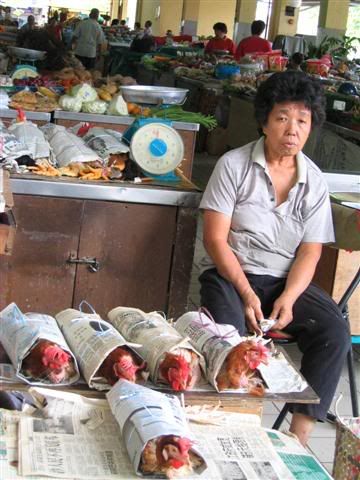
At 5am the next morning, we hopped in the hover-boat for the 9 hours trip to Belaga. Inside the cabin, a steady feed of Bruce Lee movies with sound settings on "karaoke heavy echo". Through the dirty windows, we saw many barges of timber slowly drifting downstream, logging camps on muddy banks, and dark green vegetation against the yellowish brown of the water. A very different travel experience from that of Redmond O'Hanlon in 1984, which he described in his bestseller "Into The Heart Of Borneo". Even the mighty Pelagus Rapids where passed with hardly a shake.
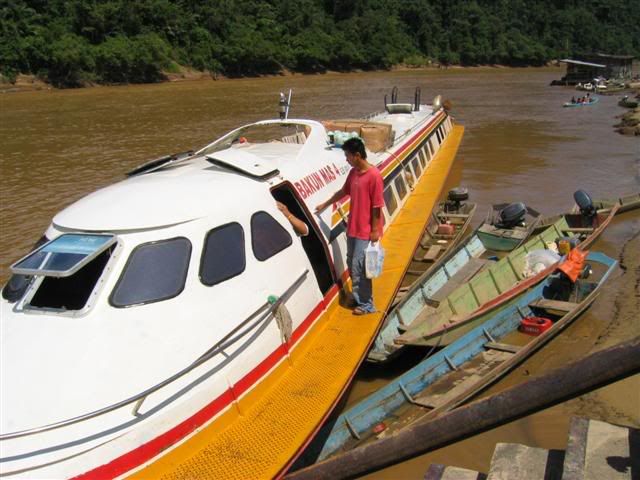
Then we arrived in Belaga, a small cowboy frontier town. Big offroaders cruise the streets, natives trade their forest products in the tiny market and at the jetty, then drown their cash in the cafes before staggering back home.
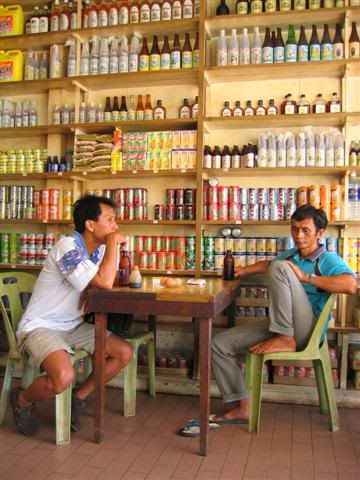
Upriver, the megalomaniac Bakun dam stops us from going further. The reservoir of the dam will submerge 700 km2 of tropical rain forest and 10,000 indigenous Kenyah and Kayan people have been forcibly relocated from their ancestral homes. They are now struggling to survive on resettlement sites, where unemployment and hunger are prevalent. The mandate to develop the project went to a timber contractor and friend of Sarawak’s governor. The provincial government of Sarawak is still looking for customers to consume the power to be generated by the project, which by far exceeds the needs of Sarawak...
From Belaga, we did a couple of excursions to "Orang Ulu" villages. The first, and most touching, was to the fading Sihan community. Formerly nomadic, they are now settled in a village 2 hours on foot from Belaga, across the river.
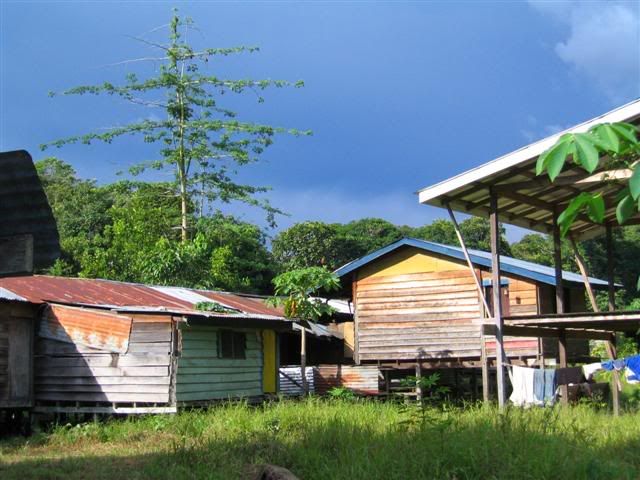
Their entire population is now only about 50. Those who don't live in the village work in Belaga. They have their own dialect, but most understand Malay. In the afternoon, they brought us fishing and fruit picking.
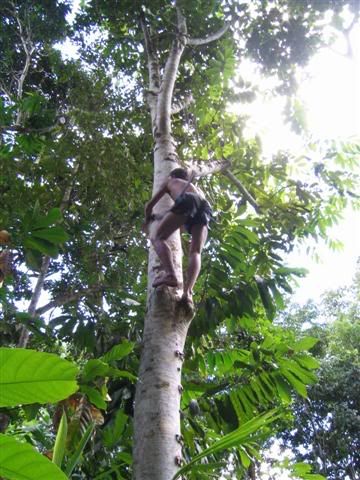
Later on came Jali, who turned out to be particularly friendly host. He helped us establish a small Sihan-Malay dictionary, and wanted to go bring us frog hunting. So we followed him with a torchlight at night up a clear and sandy shallow stream. A wonderful place with many fireflies. When a batracian got betrayed by the reflection of the light in its eyes, Jali administered a sure knock on its head, and we would pick the stiff body of the stunned creature to put it in the rotan basket. After this, we went back to his grand-mother who boiled them for us. They looked almost alive floating in the watery soup, but we tried to put on a unimpressed face and ate them all. Grand-mother preparing the rice:
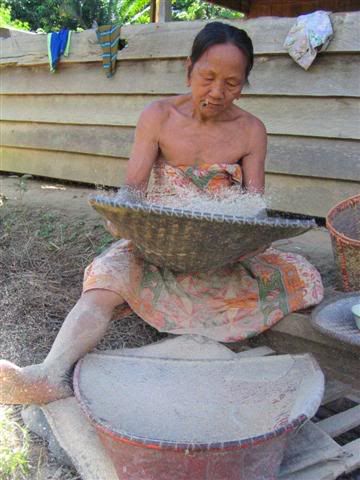
The next day, a villager shot a wildboar. Everybody was very excited. The guts were pulled out and put in a bucket for local consumption. The meat was to be sold in town... The community was very poor and needed the cash.
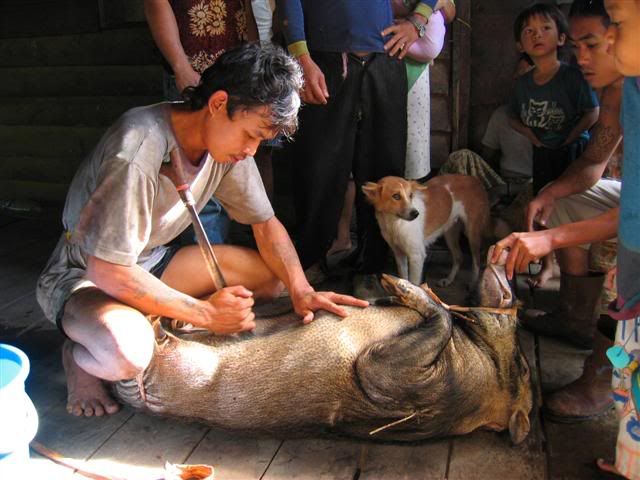
Our second visit was to a neat and relatively wealthy Kayan village 10 minutes upriver by boat. It consisted of 2 longhouses, a kindergarden, a football field and a small chapel. This stay was much less interesting than the previous one. The Kayan live in a hierachical society and are less open than the Sihan, or the Iban. Besides, our host turned out to be very unreliable. He had an alcohol problem, and got uneasy when we spoke to other people. So we dropped him and let him drink with his friends. Luckily, his parents were very nice and took care of us very well.
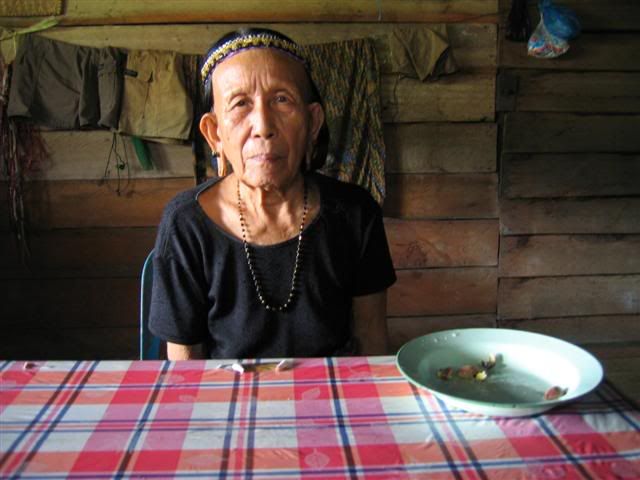
We left Belaga by 4WD, using the logging roads down to the coast to Miri. An edifying 4 hours drive among the damages of the logging industry.
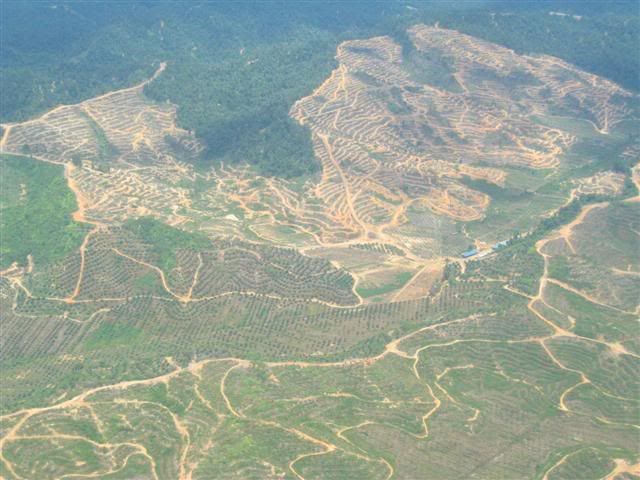
About Miri
Just weeks before we got there, Miri received the official status of "city", becoming the second in Sarawak after Kucing. Even if it is still smaller than Sibu. But there are big plans for Miri, for this oil city is to become a resort city! Some of the money of the timber and oil industry which has not been drained by the Malaysian Federal Government is here being converted to bricks and mortar. Hotels and housing lots shoot up, land is being reclaimed at the waterfront, a new bridge links the city by road to Brunei and attracts columns of the wealthy neighbours in search of cheap shopping and a bit of entertainment. But in the hurry, the authorities have neglected to improve the road system, which now can get very congested and bumpy...
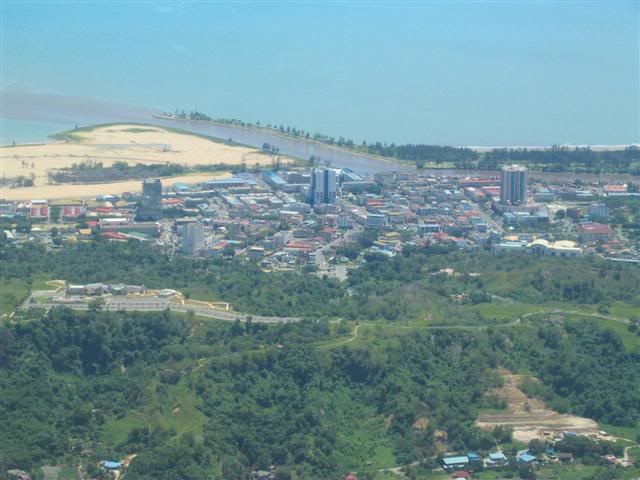
Miri is the ideal hub for expeditions to the northern interior: the tiny Twin Otters of Malaysian Airline's rural service take off daily for Bario and Mulu from the new international airport, the plethora of shopping lots are good to find supplies, and restaurants serving inexpensive and generous portions of excellent cooking offer a heavenly relief for the tired and starved trekker.
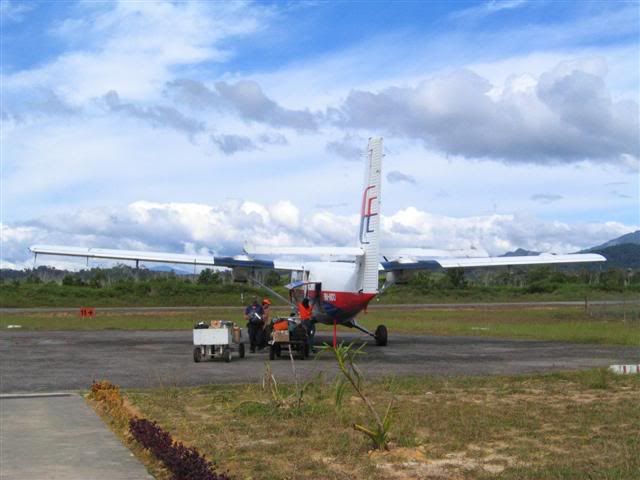
As we happened to arrive at the peak of the fruit season, more local delights were awaiting us at the market: durian, dabai, langsat, rambutan, talap, dibadak, tanpoi, maritam, mangosteen, jackfruit, bread fruit...
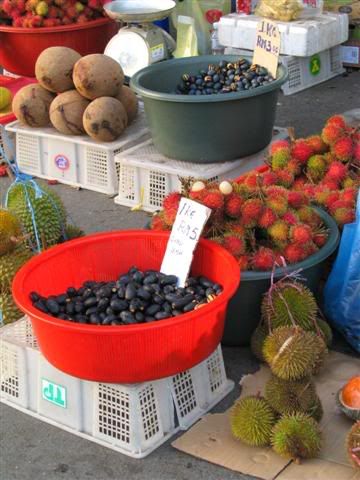
We also had the pleasure to visit some relatives there. Gilbert's auntie Maureen's family. More good humour and wonderful food (traditional Malay cooking by Grandma and auntie Rose)!
In The Rainforest
At the Highlands guesthouse in Miri, we met Willie, a Berawan. Beside being the manager, he also fights for the rights of his people, who, like many native minorities, have been stripped of their land and rights (more below, under Mulu). He came up with an interesting proposition. Instead of trodding on the well-beaten tracks in secondary forests around Bario, he suggested us a trek from Long Lellang to Bario, across the newly created Pulong Tauh national park. After a 20 year struggle, local Kelabit and Penan got the government to protect 65'000 ha of pristine primary forest. A small area and a big dissapointment considered their initial claim for over 160'000 ha.
We boarded the Twin Otter fully prepared for the challenge, or so we thought. It was to be a tough 4 days trek. We flew far in land, beyond the "ulu" of the convoluted Baram, until near the Indonesian Kalimantan border.
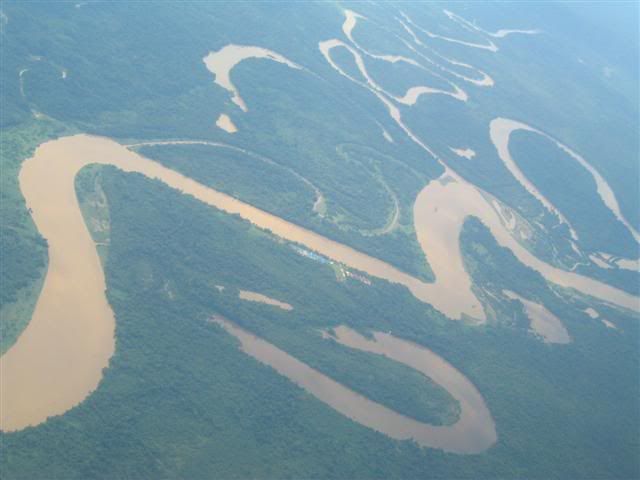
First, we were to stay one night in Long Lellang, a very neat and homely Kelabit village. Until the beginning of the 20th century, the Occident had no idea of the existence of this self-sufficient mountain community. During World War 2, their highlands were used by the English and Australians as base for the guerilla against the Japanese. After the war, Christian missionaries poured in and converted the animist Kelabit, destroying most of their culture and traditions. Nowadays, the small Kelabit community (only around 5000 people) are extremely westernised and enjoy a high level of education. Many have university degrees and work in towns like Kucing, Miri, Kuala Lumpur. Many also married Anglo-saxons and live abroad in Canada, Australia, Great Britain, the US. Many don't bother about their forest any more.
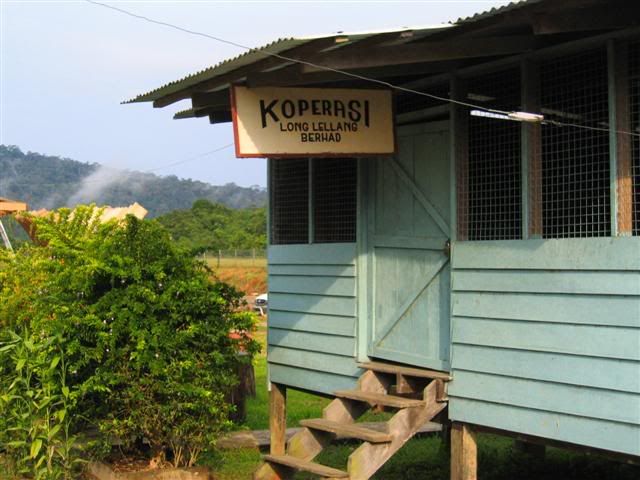
At the airport hut, a small friendly crowd was waiting for the bi-weekly flight bringing parcels, relatives and visitors. We asked around, and quickly found someone to bring us to our local Kelabit contact, with whom we would stay for the night. Our hosts were very nice. After a meal of ikan semah (the costliest fish of Sarawak, who happens to live in the nearby rivers), we went for a Sunday stroll and got introduced to half of the village. They asked us about our plans. On one or two occasions, they already had seen tourists attempting this. They told many came back after a few days, having abandonned the idea. The Tamabu Range was hard to cross, the jungle was thick, the leeches were numerous. They were surprised at Claudia's size. Usually, white women were much bigger, fatter. She would probably not succeed. Had they themselves done it? Yes, but a long time ago. 20 or 30 years ago. Now people fly.
Slightly suspicious, we nevertheless decided we would try. Surely 4 days trek, with only a night in the jungle couldn't be too bad. Later in the evening, we eventually met Balang, our Penan guide, on a plankway. It was Sunday, and he was in town to see his children staying at the school. He told us we would need 2 guides for the trek, for security reasons. So he would bring his friend Nelson with him. We were to leave the next morning for Long Sabai, his village.
At 8am, Balang, his wife, his youngest baby and Nelson were there. We were all set. The first day's walk was relatively easy. We reached the village at 16h30 and went for a refreshing wash in the river. We ate well, and had a nice time with the family. Balang's parents:
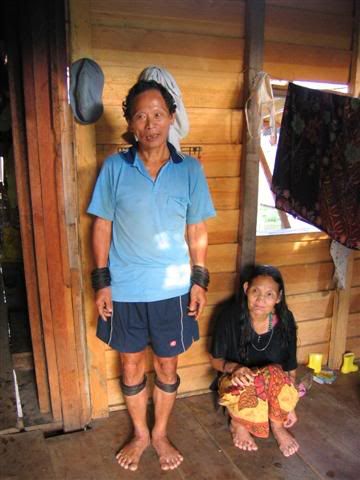
Then Balang drafted a plan of the way. Bad surprise: at this point, we were 5 days away from Bario, not 3. The plan at the Highlands, verified by talking to the Kelabit, proved to be very wrong... Being polite, Balang had acquiesed at the plan we quickly showed him on the plankway, without really looking at it. Despite being nearly 8 months in Asia, we had fallen in the classic beginner's trap again. We were so sure of our information that we just asked for a confirmation, where we should had everything explained again. In such cases, the answer could only be "yes".
Balang's plan proved right. The whole walk actually took 6 days, instead of 4. A Penan without luggage could perhaps do it in 5. Nobody can do it in 4. Very few tourists did the trip before, so most information on it was second hand...
Nevertheless, the expedition was a memorable experience! For 5 days, we followed the half overgrown Penan trails and saw nobody. Just primary forest. The sound of animals, streams, branches falling, rain. We spent 4 nights in the forest, in camps that our guides set up in less than half an hour using only their parangs (big sharp knives).
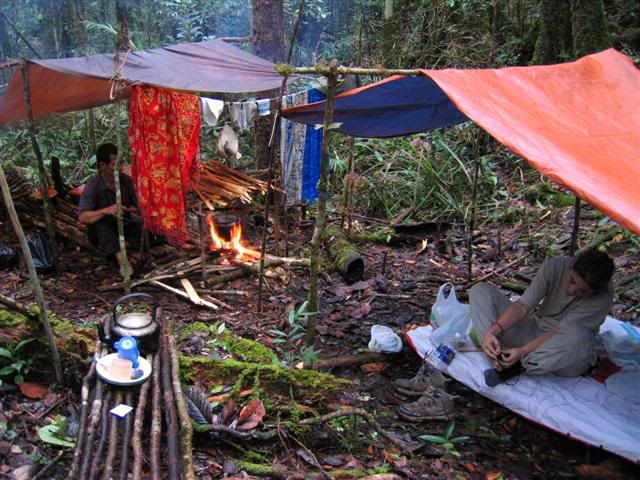
Our backpack, their backpack:
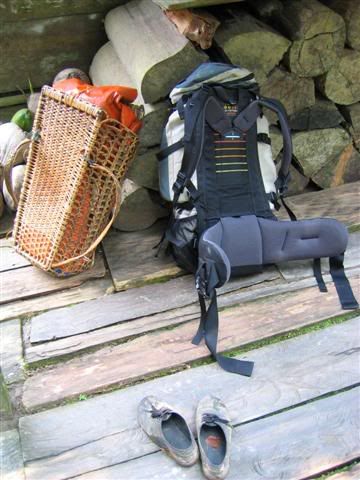
We complemented our rice and noodles with products from the jungle: sago, game. On the 3rd day, we stopped earlier, half way up the Tamabu range and Balang went hunting. He came back with a leaf monkey, whose tender meat supplied 4 meals for all of us. On the 5th day, while eating plain rice and sharing a tiny can of curry chicken by the river, a barking deer run straight in our plate. Well, not quite: we saw it cross the river, the guides ran after it in thick undergrowth of the jungle and we heard a shot. We saw the wounded animal crossing back the river, quickly followed by Nelson who gave it the final blow with his parang. As simple as that!
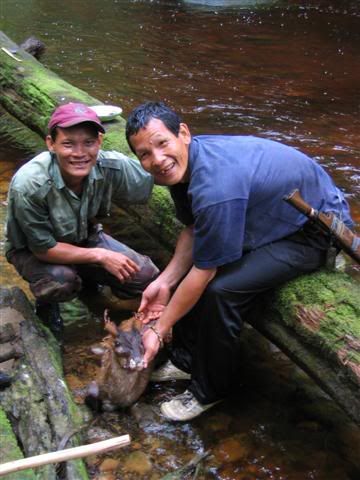
In the evenings, we usually joked and spoke about animals and plants. Our guides were very curious about wildlife and forests in Switzerland. We talked a bit about their lifestyle, but they didn't have much to say on the subject. Balang was prouder to show us that water can be boiled in a PET bottle placed in the fire! The best was to observe: in a way, words aren't very suited to explain how they cut small trees to make tents, bridges, sleeping platforms. How rottan can be used as rope and resin as fire starter. How some leafs make perfect umbrellas. How their baskets are woven. How they move fast, silently and steadily through the forest. Many things that are as natural for them as breathing.
The Penan used to get all they needed from the jungle. Before, they were exclusively nomadic. Nowadays, most families have been resettled to permanent habitations. The destruction of the primary forest, where they found their subsistance, have put them in a precarious position. The new secondary forest is much poorer: where there were 300 species of trees on a hectar, only 10 grow back. Many important medicinal plants are gone. The fauna also gets scarcer and less varied.
An ipoh tree, from which the latex is extracted for poison darts:
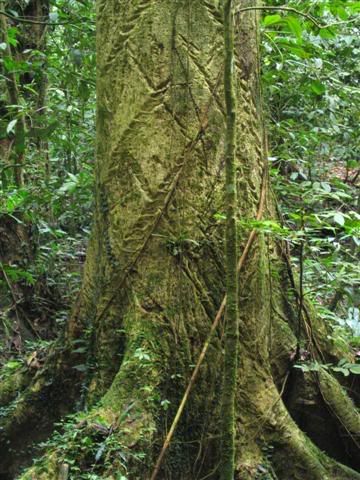
Actions to stop logging have had mixed results. The Army has been sent in to stop blockades, to intimidate the wives and children. In Malaysia, the Internal Security Act allows the detention of anyone almost indefinetly without trial if they are seen as a threat to national security. What if the men are detained, who will go hunting to feed the family? Other solutions are proposed to fight back. The legal approach is to lean on the NCR (Native Customary Rights) to file in claims on land. But documents to prove traditional ownership of land often don't exist. The business approach is to try buying shares in the timber companies to have a word in the decisions. But most timber empires belong to families and are not quoted at the market. Some propose to buy rainforest directly, as concessions. In all cases, it is a fight of David against Goliath, almost a lost cause, as the opponents are extremely rich, and have prominent friends and relatives in government and courts.
Where we were, it was all too easy to forget about the chainsaws. Some days, we walked for 10 hours, totally absorbed by this unfamiliar environement.
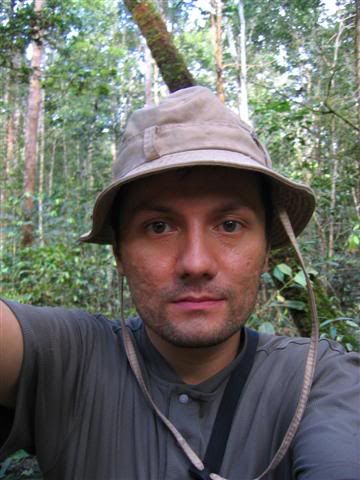
The green was soothing, and attenuated our physical tiredness. When a few sunbeams shine through the canopy, when bathing in perfectly clean stream, when hearing the early morning calls of the gibbons, the heavy flight of the hornbill or the night concerto of the cicadas, the jungle can seem like a paradise and even the stubborn assiduity of the leeches is forgiven. On the way, we saw too many wonderful things to list here. Tree trunks ripped open by sunbears for honey, huge red hardwood trees shedding their bark, strange bugs, butterflies, spiders...
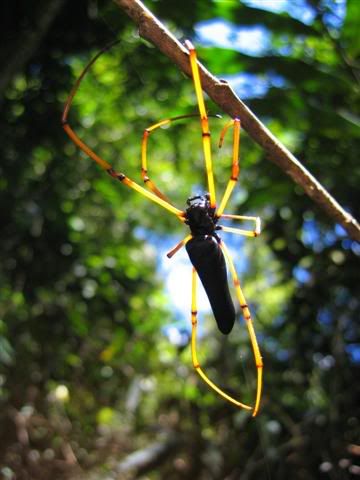
And they were the "babui" traces... Always arousing the imagination of our guides, and subject to most of their discussions in Penan language. Unfortunately, though we saw many footprints on the way, they didn't succeed in catching one of those mouth-watering wild pigs.
But when heavy rain starts pouring, the walk becomes as treacherous and vicious as hell. Everything gets darker, more slippery, shoes get sucked in the mud, streams rise, get wilder, and are more difficult to cross. The leeches get frenetic and slimier, making them all the more difficult to discard! Diverted by the little rubber vampires, it is easier to lose concentration and get caught in rottan hooks, slip in the thorny sago, oversee the sharp stubs... A leech:
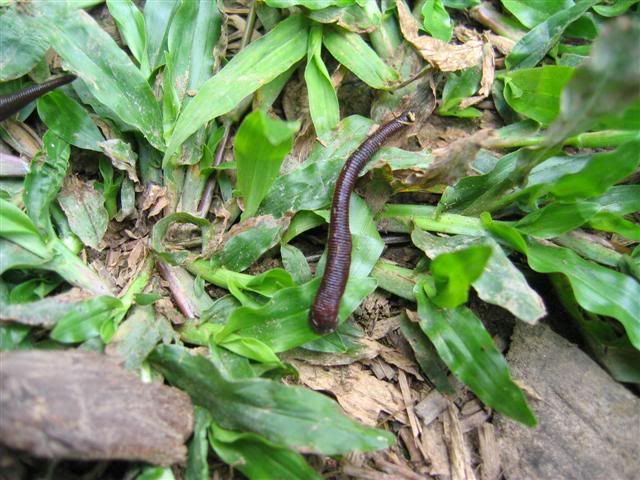
On the last day, at noon, the jungle got suddenly clearer. We were in the secondary forest near Bario. Another 7 hours walk through swampy areas and a deserted Penan village and we were back to civilisation. Exhausted but very happy and grateful to have been given the chance to experience this trip.

On the next day, we got on the Twin Otter back to Miri. From the sky, we saw the orderly fields of the Kelabit highlands, the sacred Penan twin peaks of Batu Lawi where the souls of the dead wander, and where Bruno Manser was heading when he was last seen in 2000.
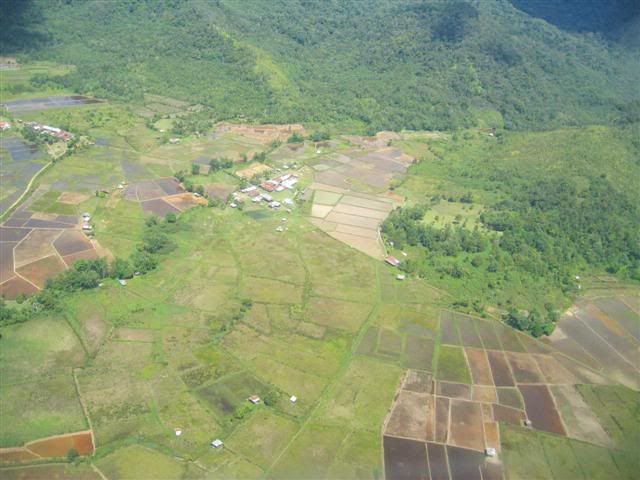
Very soon, we saw logging track creeping in the jungle like cancer. And a bit further, huge clear cut areas with palm tree plantations sponsored by the Malaysian governement. This african plant used to produce oil seals the fate of local wildlife and fauna, as it leaves no place for them, and required the use of pesticides which end up poisoning the rivers.
Mulu National Park
Our last excursion in Sarawak was to the Mulu National Park, a UNESCO World Heritage site. There, we thought the biggest cave system in the world and the climb to unusual limestone formations would provide some relaxation. Alas, the place turned out to be extremely commercialized, and dishonest. More like a funfair where every ride has to be paid for than a natural reserve. It was virtually impossible to get anywhere without a guide.
Around the headquarters, all ways to the show caves were concrete paths with hand-railings. To see the caves, one had to join a tour (for a modest fee). Quite understandable given the many visitors and the need to make sure they don't touch and damage the stalactites and stalagmites. 4 appropriately lighted so-called show-caves could be reached this way. So we complied and followed the flow of tourists in shorts.
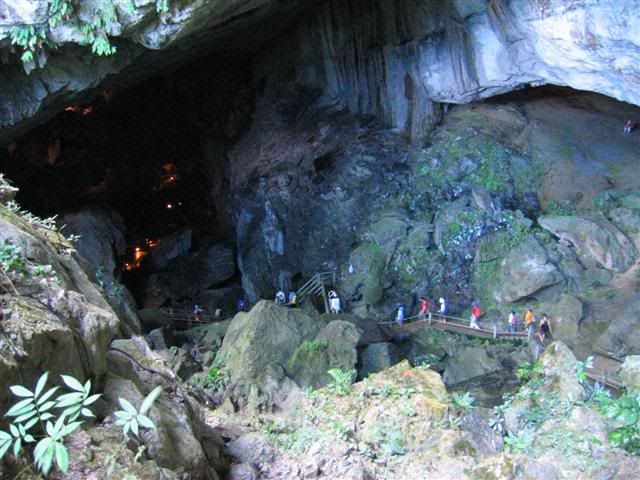
At dawn, like everyone, we watched the swarms of bats snaking out of the deer cave from the viewing sitting area. Other caves could be visited as part of "adventure caving" activities -meaning one might have to crawl at some places and perhaps get a bit wet- for quite exhorbitant fees. We decided to drop this.
Instead, we went for the pinnacles which had to be reached from Camp-5, a 1.5 hours boat trip up river and a 3 hours walk. The headquarters lied to us that their was no path there, and that the expensive boat had to be hired. We later found out the boatmen had demonstrated for the park to send them tourists. The park agreed, and organised the boat bookings taking a commission in the process. As we also had to reserve a place to stay at Camp-5 and book a mandatory guide for the pinnacles, we had no other choice than to comply with "park regulations" and joined a group of 5 to share the costs.
On the way, our guide made his usual speach about wildlife, that unfortunately was not visible at this season because it was not fruit season. But we knew there was no more wildlife in Mulu.
30 years ago, the place was full of animals. Then the park was created, and the area around the park has since been logged. The destruction of the forest deprived the local Penan of their livelihood. As compensation, they were relocated in settlements and allowed to hunt in the park... But the park was to small and hunting quickly eradicated the last surviving big animals. Now, one can only see a few lizards, pigmy squirrels, and maybe, if very lucky, a wild pig. The Penan have been turned into an attraction: they wait uneasily behind the stalls of the "traditional handicraft market" for tourists to buy their wares.
The 3 hours climb up the pinnacles was fun. The path was clearly marked and having a guide proved just a security measure for the park. The last hour was steep: the way had ladders and ropes to help get to the viewing point.
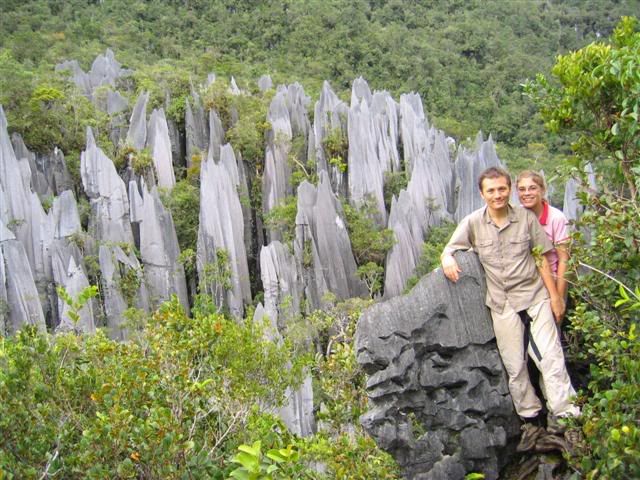
Then, we went back down to Camp-5, and returned the following day to the headquarters to catch a flight back to Miri. At the headquarters, we saw the unusual activity of locals wearing new "orang ulu" hats. The Chief Minister of Sarawak, whose family happens to own the park and the nearby 5-stars resort, paid a visit to the park to inaugurate the canopy walk. We saw him leave in his big offroad jeep, talking in his handphone without taking notice of the locals lined at the side of the road sheepishly waving at him in pseudo-traditional attire.
Later, we heard of an even more disturbing story: the blackout on the Berawan culture in Mulu. In the summer of 1993, they protested against the company operating the park, who took their land without proper compensation not only to build the park headquarters, but also a 5-stars resort with plans for a golf course. The airport, built to bring visitors to the park, also encroaches on their land. The peaceful Berawan blockade was broken by the army, who detained and ill-treated the suspected leaders.
Since then, "Berawan" is a taboo word in Mulu park: the guides feign to ignore the origin of the burial caves near the paths (when not wrongly attributing them to Penan or Kayan), the mention of the Berawan chief who opened the way up the Mulu mountain has been erased from the new brochure, and, worse, Berawan freelance guides bringing their customers are given a hard time by the park management (headed by an Australian couple) who often lie to them that accomodation is full or quotas for the pinnacle have been reached.
Today, we wouldn't bother going back there anymore.

Up The Rajang River
The first leg of our journey took us to Sibu, somewhere at the wide mouth of the murky Rajang. There, we found a bustling chinese market town with a newly redesigned modern city centre and logs of tropical wood pilled on the docks.

At 5am the next morning, we hopped in the hover-boat for the 9 hours trip to Belaga. Inside the cabin, a steady feed of Bruce Lee movies with sound settings on "karaoke heavy echo". Through the dirty windows, we saw many barges of timber slowly drifting downstream, logging camps on muddy banks, and dark green vegetation against the yellowish brown of the water. A very different travel experience from that of Redmond O'Hanlon in 1984, which he described in his bestseller "Into The Heart Of Borneo". Even the mighty Pelagus Rapids where passed with hardly a shake.

Then we arrived in Belaga, a small cowboy frontier town. Big offroaders cruise the streets, natives trade their forest products in the tiny market and at the jetty, then drown their cash in the cafes before staggering back home.

Upriver, the megalomaniac Bakun dam stops us from going further. The reservoir of the dam will submerge 700 km2 of tropical rain forest and 10,000 indigenous Kenyah and Kayan people have been forcibly relocated from their ancestral homes. They are now struggling to survive on resettlement sites, where unemployment and hunger are prevalent. The mandate to develop the project went to a timber contractor and friend of Sarawak’s governor. The provincial government of Sarawak is still looking for customers to consume the power to be generated by the project, which by far exceeds the needs of Sarawak...
From Belaga, we did a couple of excursions to "Orang Ulu" villages. The first, and most touching, was to the fading Sihan community. Formerly nomadic, they are now settled in a village 2 hours on foot from Belaga, across the river.

Their entire population is now only about 50. Those who don't live in the village work in Belaga. They have their own dialect, but most understand Malay. In the afternoon, they brought us fishing and fruit picking.

Later on came Jali, who turned out to be particularly friendly host. He helped us establish a small Sihan-Malay dictionary, and wanted to go bring us frog hunting. So we followed him with a torchlight at night up a clear and sandy shallow stream. A wonderful place with many fireflies. When a batracian got betrayed by the reflection of the light in its eyes, Jali administered a sure knock on its head, and we would pick the stiff body of the stunned creature to put it in the rotan basket. After this, we went back to his grand-mother who boiled them for us. They looked almost alive floating in the watery soup, but we tried to put on a unimpressed face and ate them all. Grand-mother preparing the rice:

The next day, a villager shot a wildboar. Everybody was very excited. The guts were pulled out and put in a bucket for local consumption. The meat was to be sold in town... The community was very poor and needed the cash.

Our second visit was to a neat and relatively wealthy Kayan village 10 minutes upriver by boat. It consisted of 2 longhouses, a kindergarden, a football field and a small chapel. This stay was much less interesting than the previous one. The Kayan live in a hierachical society and are less open than the Sihan, or the Iban. Besides, our host turned out to be very unreliable. He had an alcohol problem, and got uneasy when we spoke to other people. So we dropped him and let him drink with his friends. Luckily, his parents were very nice and took care of us very well.

We left Belaga by 4WD, using the logging roads down to the coast to Miri. An edifying 4 hours drive among the damages of the logging industry.

About Miri
Just weeks before we got there, Miri received the official status of "city", becoming the second in Sarawak after Kucing. Even if it is still smaller than Sibu. But there are big plans for Miri, for this oil city is to become a resort city! Some of the money of the timber and oil industry which has not been drained by the Malaysian Federal Government is here being converted to bricks and mortar. Hotels and housing lots shoot up, land is being reclaimed at the waterfront, a new bridge links the city by road to Brunei and attracts columns of the wealthy neighbours in search of cheap shopping and a bit of entertainment. But in the hurry, the authorities have neglected to improve the road system, which now can get very congested and bumpy...

Miri is the ideal hub for expeditions to the northern interior: the tiny Twin Otters of Malaysian Airline's rural service take off daily for Bario and Mulu from the new international airport, the plethora of shopping lots are good to find supplies, and restaurants serving inexpensive and generous portions of excellent cooking offer a heavenly relief for the tired and starved trekker.

As we happened to arrive at the peak of the fruit season, more local delights were awaiting us at the market: durian, dabai, langsat, rambutan, talap, dibadak, tanpoi, maritam, mangosteen, jackfruit, bread fruit...

We also had the pleasure to visit some relatives there. Gilbert's auntie Maureen's family. More good humour and wonderful food (traditional Malay cooking by Grandma and auntie Rose)!
In The Rainforest
At the Highlands guesthouse in Miri, we met Willie, a Berawan. Beside being the manager, he also fights for the rights of his people, who, like many native minorities, have been stripped of their land and rights (more below, under Mulu). He came up with an interesting proposition. Instead of trodding on the well-beaten tracks in secondary forests around Bario, he suggested us a trek from Long Lellang to Bario, across the newly created Pulong Tauh national park. After a 20 year struggle, local Kelabit and Penan got the government to protect 65'000 ha of pristine primary forest. A small area and a big dissapointment considered their initial claim for over 160'000 ha.
We boarded the Twin Otter fully prepared for the challenge, or so we thought. It was to be a tough 4 days trek. We flew far in land, beyond the "ulu" of the convoluted Baram, until near the Indonesian Kalimantan border.

First, we were to stay one night in Long Lellang, a very neat and homely Kelabit village. Until the beginning of the 20th century, the Occident had no idea of the existence of this self-sufficient mountain community. During World War 2, their highlands were used by the English and Australians as base for the guerilla against the Japanese. After the war, Christian missionaries poured in and converted the animist Kelabit, destroying most of their culture and traditions. Nowadays, the small Kelabit community (only around 5000 people) are extremely westernised and enjoy a high level of education. Many have university degrees and work in towns like Kucing, Miri, Kuala Lumpur. Many also married Anglo-saxons and live abroad in Canada, Australia, Great Britain, the US. Many don't bother about their forest any more.

At the airport hut, a small friendly crowd was waiting for the bi-weekly flight bringing parcels, relatives and visitors. We asked around, and quickly found someone to bring us to our local Kelabit contact, with whom we would stay for the night. Our hosts were very nice. After a meal of ikan semah (the costliest fish of Sarawak, who happens to live in the nearby rivers), we went for a Sunday stroll and got introduced to half of the village. They asked us about our plans. On one or two occasions, they already had seen tourists attempting this. They told many came back after a few days, having abandonned the idea. The Tamabu Range was hard to cross, the jungle was thick, the leeches were numerous. They were surprised at Claudia's size. Usually, white women were much bigger, fatter. She would probably not succeed. Had they themselves done it? Yes, but a long time ago. 20 or 30 years ago. Now people fly.
Slightly suspicious, we nevertheless decided we would try. Surely 4 days trek, with only a night in the jungle couldn't be too bad. Later in the evening, we eventually met Balang, our Penan guide, on a plankway. It was Sunday, and he was in town to see his children staying at the school. He told us we would need 2 guides for the trek, for security reasons. So he would bring his friend Nelson with him. We were to leave the next morning for Long Sabai, his village.
At 8am, Balang, his wife, his youngest baby and Nelson were there. We were all set. The first day's walk was relatively easy. We reached the village at 16h30 and went for a refreshing wash in the river. We ate well, and had a nice time with the family. Balang's parents:

Then Balang drafted a plan of the way. Bad surprise: at this point, we were 5 days away from Bario, not 3. The plan at the Highlands, verified by talking to the Kelabit, proved to be very wrong... Being polite, Balang had acquiesed at the plan we quickly showed him on the plankway, without really looking at it. Despite being nearly 8 months in Asia, we had fallen in the classic beginner's trap again. We were so sure of our information that we just asked for a confirmation, where we should had everything explained again. In such cases, the answer could only be "yes".
Balang's plan proved right. The whole walk actually took 6 days, instead of 4. A Penan without luggage could perhaps do it in 5. Nobody can do it in 4. Very few tourists did the trip before, so most information on it was second hand...
Nevertheless, the expedition was a memorable experience! For 5 days, we followed the half overgrown Penan trails and saw nobody. Just primary forest. The sound of animals, streams, branches falling, rain. We spent 4 nights in the forest, in camps that our guides set up in less than half an hour using only their parangs (big sharp knives).

Our backpack, their backpack:

We complemented our rice and noodles with products from the jungle: sago, game. On the 3rd day, we stopped earlier, half way up the Tamabu range and Balang went hunting. He came back with a leaf monkey, whose tender meat supplied 4 meals for all of us. On the 5th day, while eating plain rice and sharing a tiny can of curry chicken by the river, a barking deer run straight in our plate. Well, not quite: we saw it cross the river, the guides ran after it in thick undergrowth of the jungle and we heard a shot. We saw the wounded animal crossing back the river, quickly followed by Nelson who gave it the final blow with his parang. As simple as that!

In the evenings, we usually joked and spoke about animals and plants. Our guides were very curious about wildlife and forests in Switzerland. We talked a bit about their lifestyle, but they didn't have much to say on the subject. Balang was prouder to show us that water can be boiled in a PET bottle placed in the fire! The best was to observe: in a way, words aren't very suited to explain how they cut small trees to make tents, bridges, sleeping platforms. How rottan can be used as rope and resin as fire starter. How some leafs make perfect umbrellas. How their baskets are woven. How they move fast, silently and steadily through the forest. Many things that are as natural for them as breathing.
The Penan used to get all they needed from the jungle. Before, they were exclusively nomadic. Nowadays, most families have been resettled to permanent habitations. The destruction of the primary forest, where they found their subsistance, have put them in a precarious position. The new secondary forest is much poorer: where there were 300 species of trees on a hectar, only 10 grow back. Many important medicinal plants are gone. The fauna also gets scarcer and less varied.
An ipoh tree, from which the latex is extracted for poison darts:

Actions to stop logging have had mixed results. The Army has been sent in to stop blockades, to intimidate the wives and children. In Malaysia, the Internal Security Act allows the detention of anyone almost indefinetly without trial if they are seen as a threat to national security. What if the men are detained, who will go hunting to feed the family? Other solutions are proposed to fight back. The legal approach is to lean on the NCR (Native Customary Rights) to file in claims on land. But documents to prove traditional ownership of land often don't exist. The business approach is to try buying shares in the timber companies to have a word in the decisions. But most timber empires belong to families and are not quoted at the market. Some propose to buy rainforest directly, as concessions. In all cases, it is a fight of David against Goliath, almost a lost cause, as the opponents are extremely rich, and have prominent friends and relatives in government and courts.
Where we were, it was all too easy to forget about the chainsaws. Some days, we walked for 10 hours, totally absorbed by this unfamiliar environement.

The green was soothing, and attenuated our physical tiredness. When a few sunbeams shine through the canopy, when bathing in perfectly clean stream, when hearing the early morning calls of the gibbons, the heavy flight of the hornbill or the night concerto of the cicadas, the jungle can seem like a paradise and even the stubborn assiduity of the leeches is forgiven. On the way, we saw too many wonderful things to list here. Tree trunks ripped open by sunbears for honey, huge red hardwood trees shedding their bark, strange bugs, butterflies, spiders...

And they were the "babui" traces... Always arousing the imagination of our guides, and subject to most of their discussions in Penan language. Unfortunately, though we saw many footprints on the way, they didn't succeed in catching one of those mouth-watering wild pigs.
But when heavy rain starts pouring, the walk becomes as treacherous and vicious as hell. Everything gets darker, more slippery, shoes get sucked in the mud, streams rise, get wilder, and are more difficult to cross. The leeches get frenetic and slimier, making them all the more difficult to discard! Diverted by the little rubber vampires, it is easier to lose concentration and get caught in rottan hooks, slip in the thorny sago, oversee the sharp stubs... A leech:

On the last day, at noon, the jungle got suddenly clearer. We were in the secondary forest near Bario. Another 7 hours walk through swampy areas and a deserted Penan village and we were back to civilisation. Exhausted but very happy and grateful to have been given the chance to experience this trip.

On the next day, we got on the Twin Otter back to Miri. From the sky, we saw the orderly fields of the Kelabit highlands, the sacred Penan twin peaks of Batu Lawi where the souls of the dead wander, and where Bruno Manser was heading when he was last seen in 2000.

Very soon, we saw logging track creeping in the jungle like cancer. And a bit further, huge clear cut areas with palm tree plantations sponsored by the Malaysian governement. This african plant used to produce oil seals the fate of local wildlife and fauna, as it leaves no place for them, and required the use of pesticides which end up poisoning the rivers.
Mulu National Park
Our last excursion in Sarawak was to the Mulu National Park, a UNESCO World Heritage site. There, we thought the biggest cave system in the world and the climb to unusual limestone formations would provide some relaxation. Alas, the place turned out to be extremely commercialized, and dishonest. More like a funfair where every ride has to be paid for than a natural reserve. It was virtually impossible to get anywhere without a guide.
Around the headquarters, all ways to the show caves were concrete paths with hand-railings. To see the caves, one had to join a tour (for a modest fee). Quite understandable given the many visitors and the need to make sure they don't touch and damage the stalactites and stalagmites. 4 appropriately lighted so-called show-caves could be reached this way. So we complied and followed the flow of tourists in shorts.

At dawn, like everyone, we watched the swarms of bats snaking out of the deer cave from the viewing sitting area. Other caves could be visited as part of "adventure caving" activities -meaning one might have to crawl at some places and perhaps get a bit wet- for quite exhorbitant fees. We decided to drop this.
Instead, we went for the pinnacles which had to be reached from Camp-5, a 1.5 hours boat trip up river and a 3 hours walk. The headquarters lied to us that their was no path there, and that the expensive boat had to be hired. We later found out the boatmen had demonstrated for the park to send them tourists. The park agreed, and organised the boat bookings taking a commission in the process. As we also had to reserve a place to stay at Camp-5 and book a mandatory guide for the pinnacles, we had no other choice than to comply with "park regulations" and joined a group of 5 to share the costs.
On the way, our guide made his usual speach about wildlife, that unfortunately was not visible at this season because it was not fruit season. But we knew there was no more wildlife in Mulu.
30 years ago, the place was full of animals. Then the park was created, and the area around the park has since been logged. The destruction of the forest deprived the local Penan of their livelihood. As compensation, they were relocated in settlements and allowed to hunt in the park... But the park was to small and hunting quickly eradicated the last surviving big animals. Now, one can only see a few lizards, pigmy squirrels, and maybe, if very lucky, a wild pig. The Penan have been turned into an attraction: they wait uneasily behind the stalls of the "traditional handicraft market" for tourists to buy their wares.
The 3 hours climb up the pinnacles was fun. The path was clearly marked and having a guide proved just a security measure for the park. The last hour was steep: the way had ladders and ropes to help get to the viewing point.

Then, we went back down to Camp-5, and returned the following day to the headquarters to catch a flight back to Miri. At the headquarters, we saw the unusual activity of locals wearing new "orang ulu" hats. The Chief Minister of Sarawak, whose family happens to own the park and the nearby 5-stars resort, paid a visit to the park to inaugurate the canopy walk. We saw him leave in his big offroad jeep, talking in his handphone without taking notice of the locals lined at the side of the road sheepishly waving at him in pseudo-traditional attire.
Later, we heard of an even more disturbing story: the blackout on the Berawan culture in Mulu. In the summer of 1993, they protested against the company operating the park, who took their land without proper compensation not only to build the park headquarters, but also a 5-stars resort with plans for a golf course. The airport, built to bring visitors to the park, also encroaches on their land. The peaceful Berawan blockade was broken by the army, who detained and ill-treated the suspected leaders.
Since then, "Berawan" is a taboo word in Mulu park: the guides feign to ignore the origin of the burial caves near the paths (when not wrongly attributing them to Penan or Kayan), the mention of the Berawan chief who opened the way up the Mulu mountain has been erased from the new brochure, and, worse, Berawan freelance guides bringing their customers are given a hard time by the park management (headed by an Australian couple) who often lie to them that accomodation is full or quotas for the pinnacle have been reached.
Today, we wouldn't bother going back there anymore.
